The content of this introduction paper is based on the article 'Design and Development of Energy Efficient Single Phase Induction Motor For Ceiling Fan Using Taguchi's Orthogonal Arrays' published by ['IEEE International Conference on Computing, Power and Communication Technologies (GUCON)'].
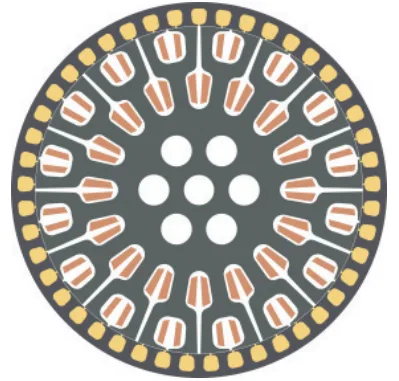
1. Overview:
- Title: Design and Development of Energy Efficient Single Phase Induction Motor For Ceiling Fan Using Taguchi's Orthogonal Arrays
- Author: Utkarsh Sharma, Bhim Singh
- Year of publication: 2020
- Journal/academic society of publication: 2020 IEEE International Conference on Computing, Power and Communication Technologies (GUCON)
- Keywords: AC Fans, Taguchi's Orthogonal Array, Single Phase Induction Motor, Home Appliances.
2. Abstract:
The conventional single phase induction motor (SPIM) based ceiling fans are difficult to design using the analytical procedure because of inherent non-linearities in the electromagnetic construction. The high skew of rotor bars to eliminate the effect of low order harmonics, makes the analytical solution based on 2D magnetic circuit, quite inaccurate. This paper deals with the systematic design and experimental validation of the energy-energy efficient SPIM for ceiling fan application. A systematic approach starting from the existing SPIM is presented for improvement in the efficiency of the motor using 2D finite element analysis. The process involves the design validation of the existing ceiling fan motor followed by a set of design of experiments (2D multi slice time stepping transient finite element analysis) to obtain the energy efficient motor. Taguchi's orthogonal arrays are used for the improvement in the performance of the motor.
3. Introduction:
Ceiling fans, invented by Philip Diehl in 1895, primarily circulate air to provide cooling. Permanent capacitor single-phase induction motors (PCSPIMs) are commonly used due to their ease of manufacture, good power factor, and long lifespan. Designing these motors, especially outer rotor types used in ceiling fans, is complex due to constraints like winding placement, stator saturation, rotor slot size, and material volume compromise. Existing design literature primarily focuses on inner rotor SPIMs. Accurate analytical modeling of ceiling fan SPIMs is difficult due to unequal magnetic circuit lengths, high rotor bar skew, and prominent winding overhang.
4. Summary of the study:
Background of the research topic:
Ceiling fan design using Single-Phase Induction Motors (SPIMs) is challenging due to inherent non-linearities and the need for high rotor bar skew.
Status of previous research:
Existing literature mainly focuses on inner rotor SPIMs, with limited research on outer rotor designs used in ceiling fans. Analytical modeling is complicated by factors like unequal magnetic circuit lengths and high rotor skew.
Purpose of the study:
To present a systematic design and experimental validation of an energy-efficient SPIM for ceiling fan applications.
Core study:
Improvement of SPIM efficiency using 2D Finite Element Analysis (FEA) and Taguchi's orthogonal arrays.
5. Research Methodology
Research Design:
A multi-level robust design process using five stages, employing Taguchi's orthogonal arrays to minimize the number of FEA simulations.
Data Collection and Analysis Methods:
2D multi-slice time-stepping transient FEA simulations. Taguchi's method was used to analyze the effect of design variables on motor efficiency. Statistical relations were used to predict optimal levels for each design variable.
Research Topics and Scope:
Validation of an existing commercial SPIM ceiling fan. Optimization of stator and rotor parameters using orthogonal matrices. Further tuning of parameters for performance improvement.
6. Key Results:
Key Results:
- The existing commercial ceiling fan motor was validated using FEA.
- Stator and rotor parameters were optimized using Taguchi's L18 orthogonal arrays.
- Further refinement was performed using L4 and L8 arrays.
- A final design with significantly improved efficiency was achieved.
- The improved design showed reduced saturation levels in the flux density plots.
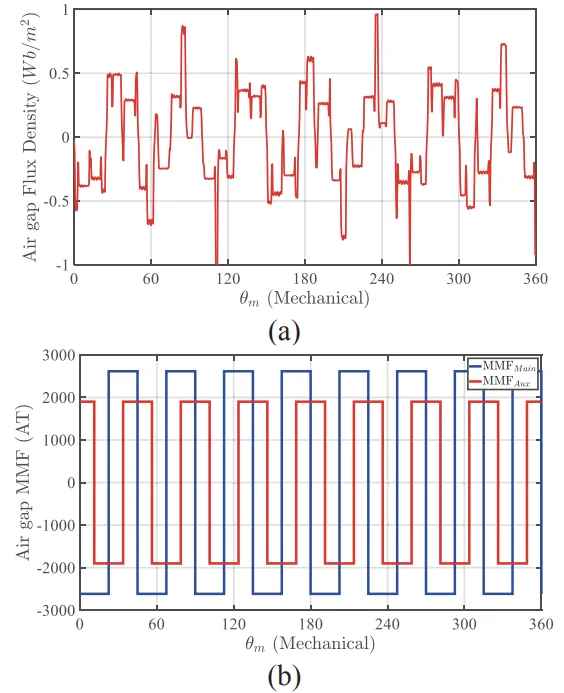

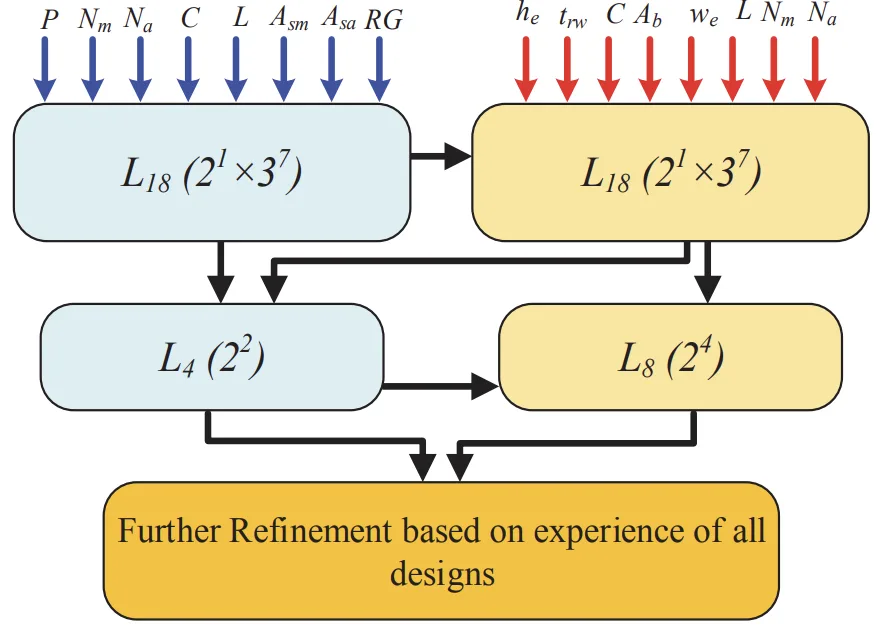
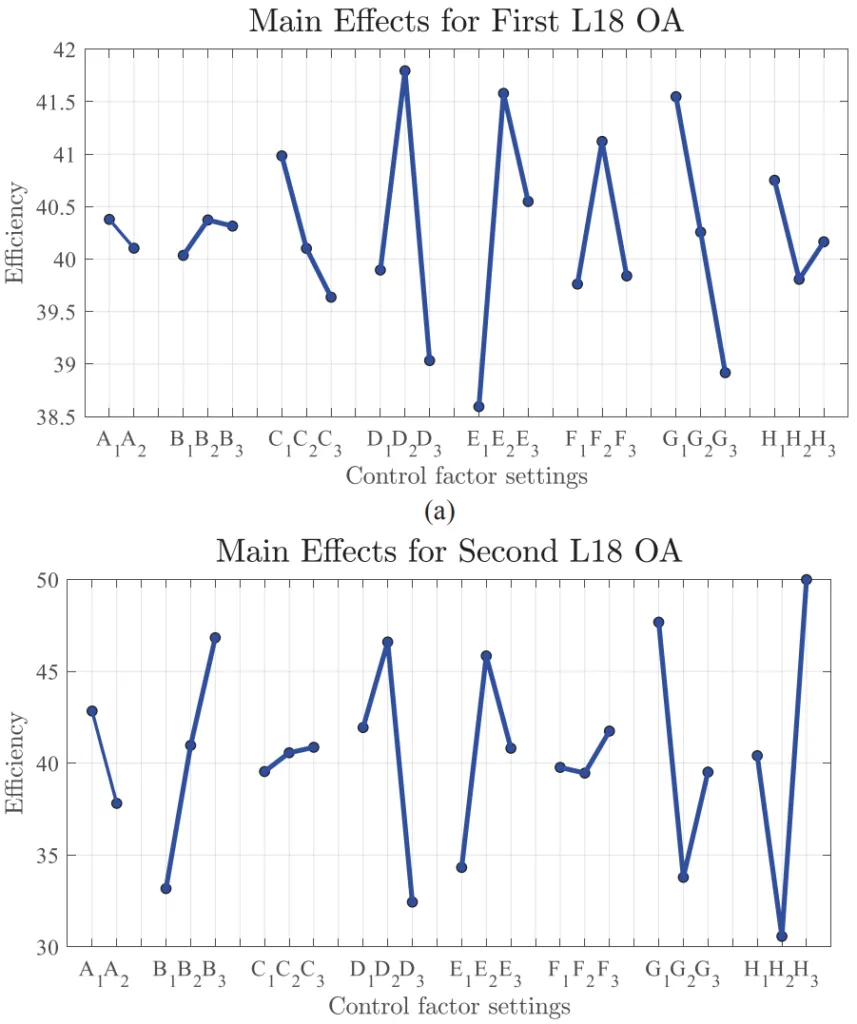
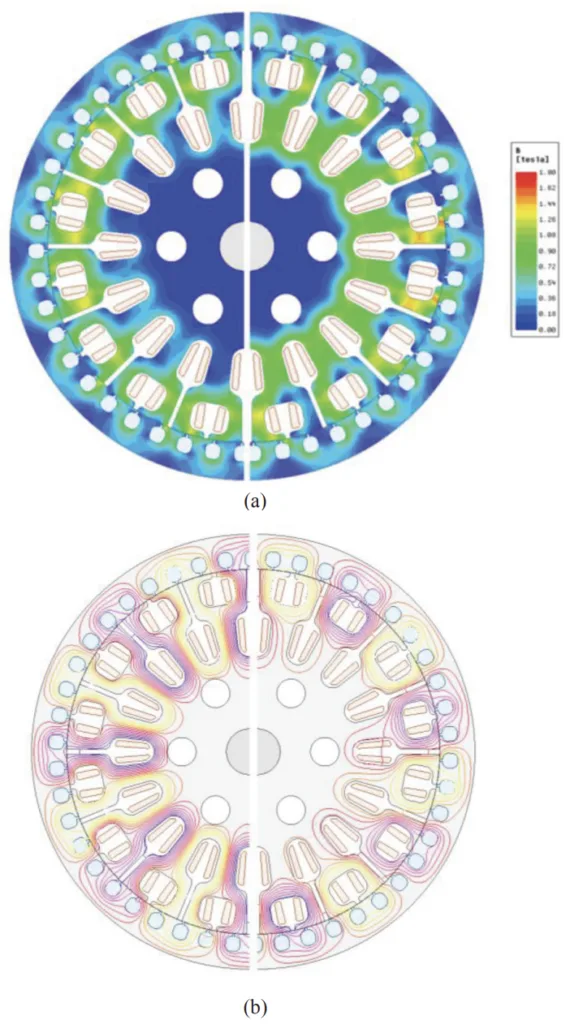

Figure Name List:
- Fig. 1 Cross section of ceiling fan SPIM
- Fig. 2 (a) Airgap flux density (b) Air gap MMF in a 16 Pole ceiling fan SPIM
- Fig. 3 Commercial ceiling fan stator (b) rated performance of the motor
- Fig. 4 Flux density plot of the existing ceiling fan motor at rated loading
- Fig. 5 Stages of formation of Orthogonal Arrays of Runs
- Fig. 6 Analysis of averages plot for (a) First L18 OA (b) Second L18 OA
- Fig. 7 Analysis of averages plot for (a) L4 OA (b) L8 OA
- Fig. 9 (a) Flux density plot for the improved design motor (b) flux lines plot for the improved design motor.
- Fig. 10 (a) Air gap radial flux density plot wrt mechanical angle (b) Harmonic spectrum of the air gap flux density (c) winding currents (d) Torque vs Speed characteristics of motor and load for improved design
7. Conclusion:
A single-phase induction motor for ceiling fan applications was designed, developed, and tested. Taguchi's orthogonal arrays were used to handle the complex nonlinear behavior and discrete design variables. Stator and rotor were tuned through simulations.
A single phase induction motor for ceiling fan application with improvement in efficiency and service factor has been designed, developed and tested with satisfactory performance. The improved design of the motor is approached using the Taguchi's orthogonal arrays because of complex nonlinear behavior of the motor and discrete nature of the design variables for feasible manufacturing. The stator and rotor are broadly tuned with set of simulations with higher number of simulations runs. Further, they are fine tuned for improvement in the performance. The input wattage is much lower than the existing fan. Thus, a feasible improved design for ceiling SPIM is achieved.
8. References:
- [1] Philip Diehl, "Electric fan", US Patent no. US550042A, November 1895.
- [2] Keith I. Hoemann and Alan R. Barker, "Tapped auxiliary winding for multi-speed operation of electric motor and method therefor" US Patent no. US4486699A, April 1983.
- [3] Kenichi Iwata Takada, "Induction motor and ceiling fan equipped with same", Japanese Patent no. WO2013132775A1, February 2013.
- [4] C.G. Veinott, Theory and design of small induction motors, McGraw-Hill, 1959.
- [5] Ion Boldea and Syed A. Nasar, The Induction Machines Design Handbook, 2nd Edition, CRC Press, December 2009.
- [6] C. P. Steinmetz, "Notes on Single-Phase Induction Motors, and The Self- Starting Condenser Motor," Trans. of the American Institute of Electrical Engineers, vol. XVII, pp. 25-72, Jan. 1900.
- [7] D. Y. Um and G. S. Park, "Determination Scheme of Stator Parameters for Making Rotating Fields Circular in a Single-Phase Induction Motor,' IEEE Trans. on Magnetics, vol. 56, no. 1, pp. 1-5, Jan. 2020.
- [8] M. Ojaghi and S. Daliri, "Analytic Model for Performance Study and Computer-Aided Design of Single-Phase Shaded-Pole Induction Motors," IEEE Trans. on Energy Conversion, vol. 32, no. 2, pp. 649-657, June 2017.
- [9] Z. Nasiri-Gheidari and H. Lesani, "Optimal Design of Adjustable Air- Gap, Two-Speed, Capacitor-Run, Single-Phase Axial Flux Induction Motors," IEEE Trans. on Energy Conversion, vol. 28, no. 3, pp. 543-552, Sept. 2013.
- [10] M. Popescu, D. M. Ionel, S. J. Dellinger, T. J. E. Miller and M. McGilp, "Analysis and design of a two-speed single-phase induction motor with 2 and 18 pole special windings," IEEE Trans. on Energy Conversion, vol. 20, no. 1, pp. 62-70, March 2005.
- [11] Xiuhe Wang, Changqing Zhu, Rong Zhang, Renyuan Tang and Hahn Song-Yop, "Performance analysis of single-phase induction motor based on voltage source complex finite-element analysis," IEEE Trans. on Magnetics, vol. 42, no. 4, pp. 587-590, April 2006.
- [12] Gun Hee Jang and S. J. Park, "Characterization of a single-phase induction motor due to the effect of slot opening," IEEE Trans. on Magnetics, vol. 40, no. 4, pp. 2065-2067, July 2004.
- [13] Hyuk Nam, Seung-Kyu Jung, Gyu-Hong Kang, Jung-Pyo Hong, Tae-Uk Jung and Seung-Myun Baek, "Design of pole-change single-phase induction motor for household appliances," IEEE Trans. on Industry Applications, vol. 40, no. 3, pp. 780-788, May-June 2004.
- [14] H. Saneie and Z. Nasiri-Gheidari, "Performance Analysis of Outer-Rotor Single-Phase Induction Motor Based on Magnetic Equivalent Circuit (MEC)," IEEE Transactions on Industrial Electronics (Early Access).
- [15] U. Sharma and B. Singh, "An Approach to Design of Energy Efficient Single Phase Induction Motor for Ceiling Fans," IEEE International Electric Machines & Drives Conference (IEMDC), San Diego, CA, USA, 2019, pp. 1452-1457.
- [16] D. Ishak, T. L. Tiang and S. K. Choy, "Performance evaluation of permanent split-capacitor single-phase induction motor for ceiling fan application," 18th International Conference on Electrical Machines and Systems (ICEMS), Pattaya, 2015, pp. 1865-1870.
- [17] Y. Guo, J. Si, C. Gao, H. Feng and C. Gan, "Improved Fuzzy-Based Taguchi Method for Multi-Objective Optimization of Direct-Drive Permanent Magnet Synchronous Motors," IEEE Trans. on Magnetics, vol. 55, no. 6, pp. 1-4, June 2019.
- [18] J. Song, F. Dong, J. Zhao, S. Lu, S. Dou and H. Wang, "Optimal design of permanent magnet linear synchronous motors based on Taguchi method," IET Electric Power Applications, vol. 11, no. 1, pp. 41-48, 1 2017.
- [19] W. Zhao, A. Ma, J. Ji, X. Chen and T. Yao, "Multiobjective Optimization of a Double-Side Linear Vernier PM Motor Using Response Surface Method and Differential Evolution," IEEE Trans. on Industrial Electronics, vol. 67, no. 1, pp. 80-90, Jan. 2020.
- [20] Kai Yang and Basem El-Haik, Taguchi's Orthogonal Array Experiment, in Design for Six Sigma: A Roadmap for Product Development, McGraw- Hill, 2008.
- [21] Juha Pyrhonen, Tapani Jokinen, Valeria Hrabovcova, 'Design of Rotating Electrical Machines', 2nd Edition, Wiley, September 2013.
- [22] Thomas A. Lipo, 'Introduction to AC Machine Design', Wiley-IEEE Press, October 2017.
9. Copyright:
- This material is a paper by "Utkarsh Sharma, Bhim Singh". Based on "Design and Development of Energy Efficient Single Phase Induction Motor For Ceiling Fan Using Taguchi's Orthogonal Arrays".
- Source of the paper: [DOI: Not provided in the paper, but it is an IEEE conference paper.]
This material is summarized based on the above paper, and unauthorized use for commercial purposes is prohibited.
Copyright © 2025 CASTMAN. All rights reserved.